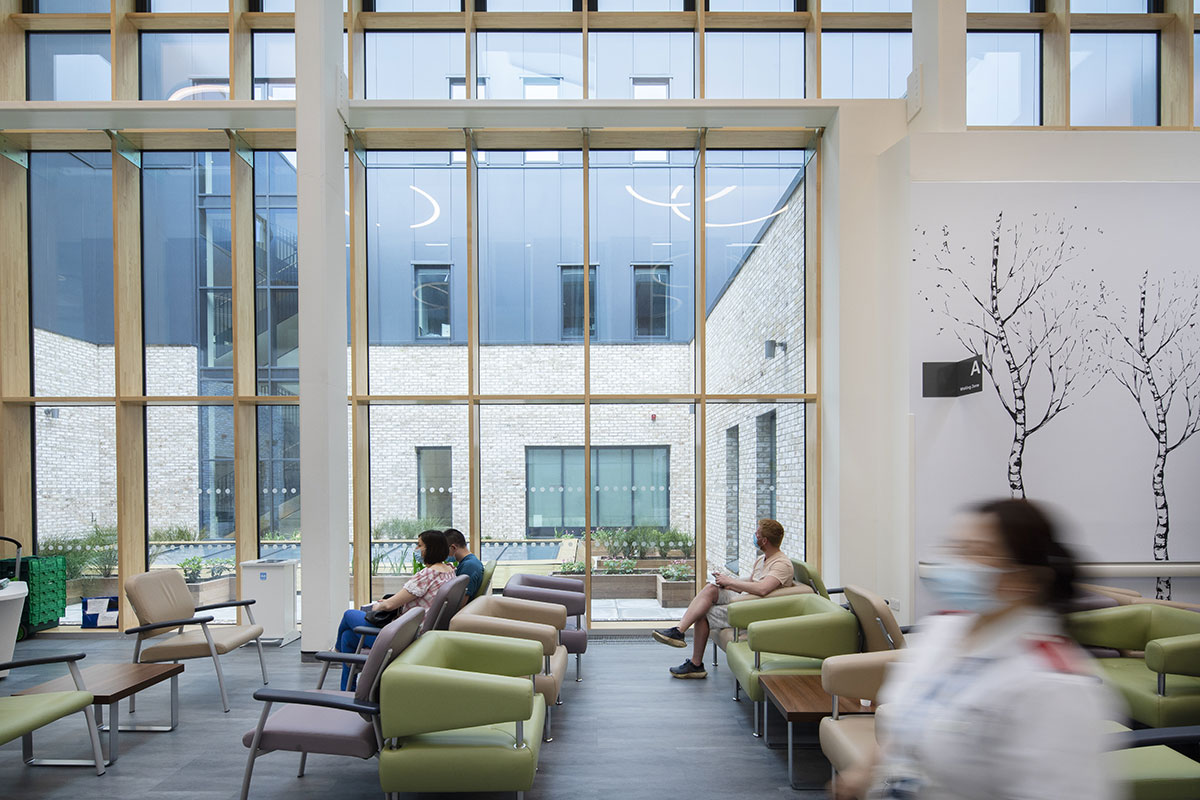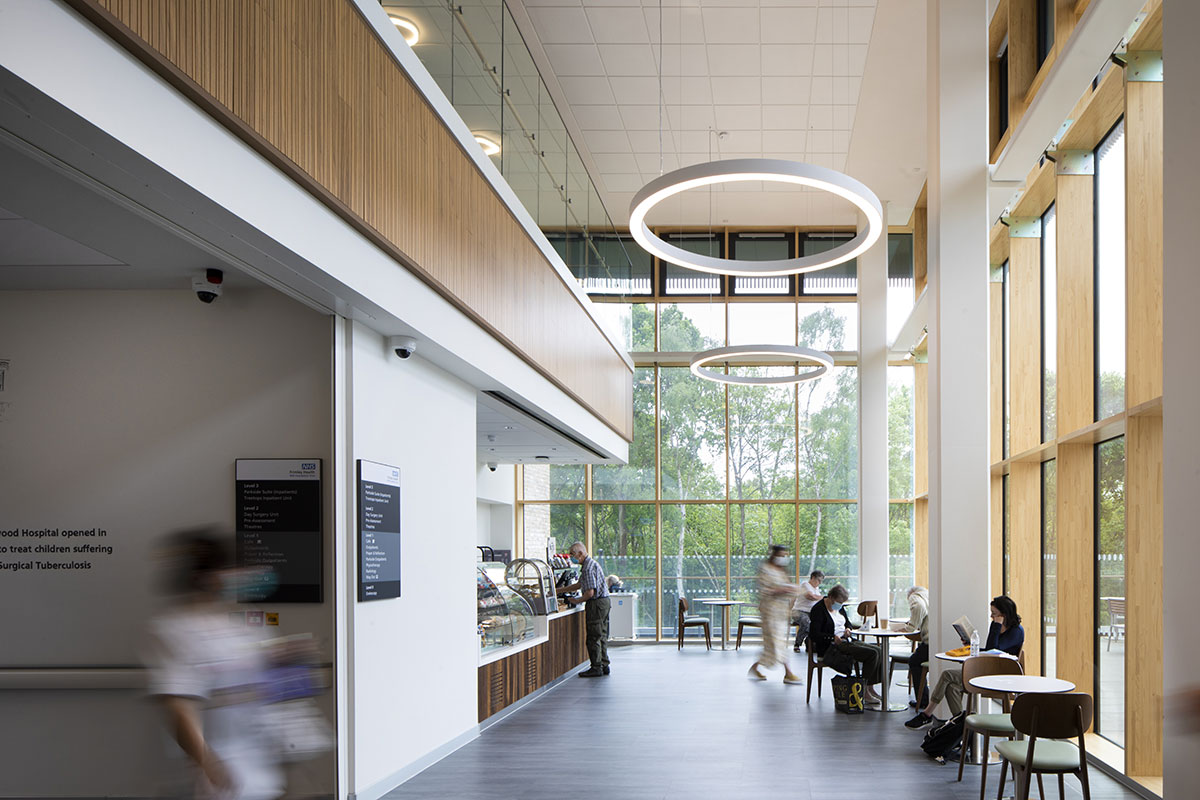#{Title}
#{Copy}
A year since the completion of the new Heatherwood Hospital in Berkshire, the new specialist, planned care facility has helped support positive outcomes for the health of the region.
Ascot has been home to a hospital at Heatherwood for almost a century, originally a tuberculosis sanitorium for children. In 2018, with ageing facilities and a growing need for investment, the hospital’s long-term future was in doubt. Designed by BDP and built by Kier Construction, the new £98million Heatherwood Hospital is an elective facility focused on orthopaedic and high volume, low acuity procedures, set within beautiful woodland surroundings. In addition to its six ultra clean theatres, it features a 48-bed inpatient unit, plus outpatient and diagnostic facilities for orthopaedics, cardiology, radiology, lithotripsy, physiotherapy, and orthodontics.
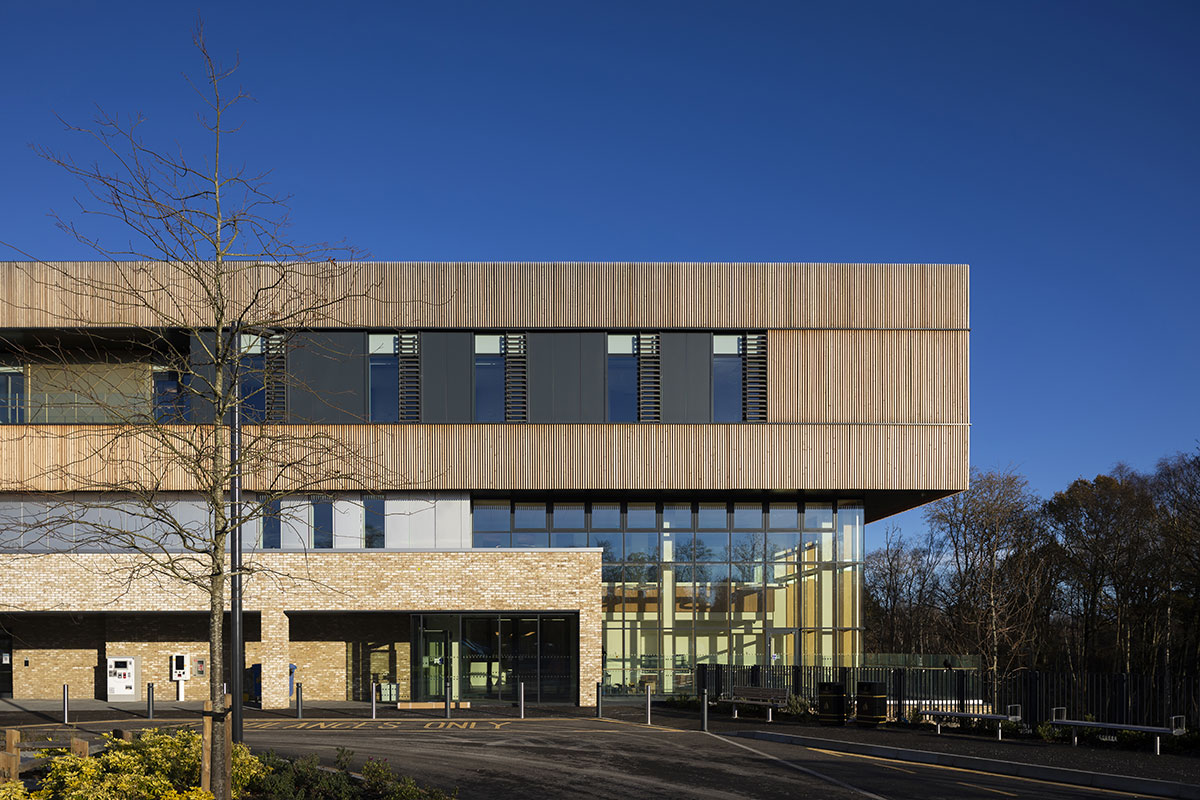
The new hospital, designed by BDP, opened in 2022 and has shown to be a great success for its client Frimley Health NHS Foundation Trust. The new hospital has reduced waiting times for patients needing knee and hip replacements, with more than 1000 joint replacements performed in the last ten months – up 20% on the number of procedures carried out pre-Covid. As a specialist planned care facility, Heatherwood has been able to perform surgery six days a week - with four out of its six state-of-the-art theatres dedicated to orthopaedic procedures. The hospital has also successfully reduced the length of time patients stay in hospital, with 40% of patients safely discharged within 24 hours. Historically, patients who underwent knee or hip joint replacement surgery would spend an average of three to four days in hospital to recover, however at Heatherwood many patients have been able to go home on the same day as surgery.
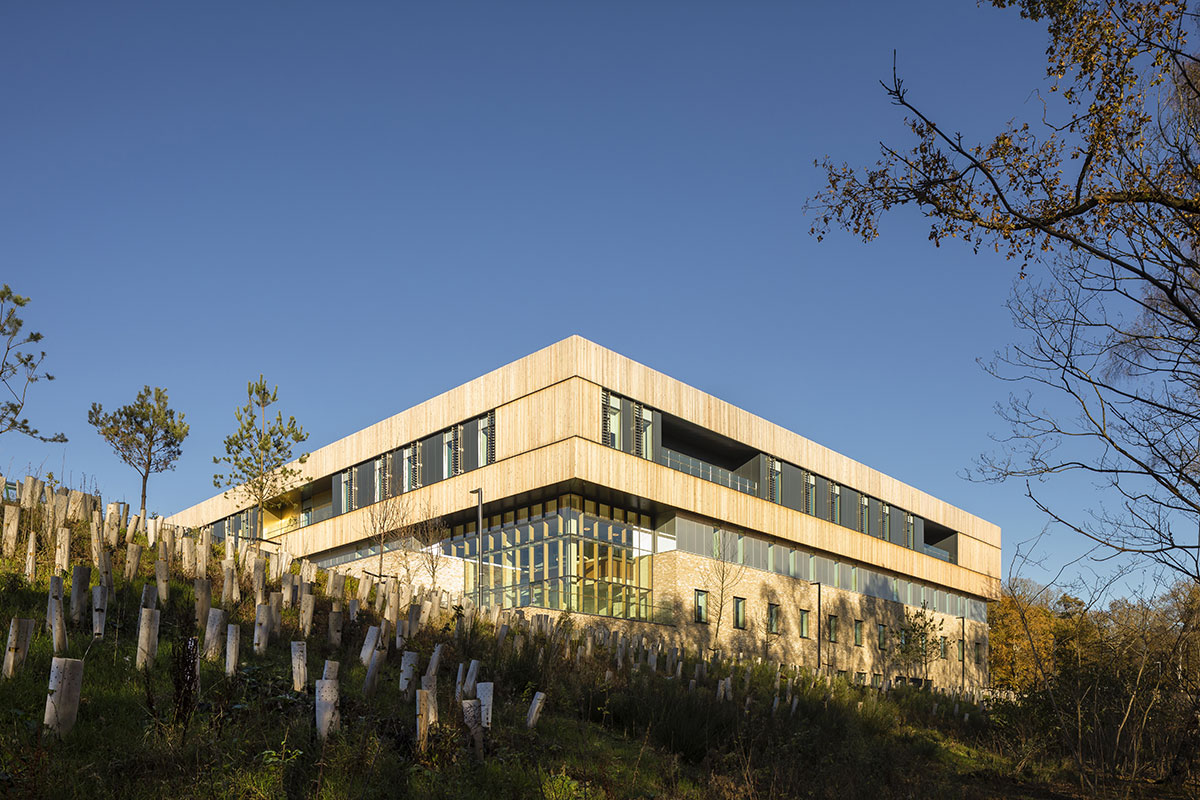
Our aim architecturally was to deliver a fantastic experience for both staff and patients, with uplifting public space, and access – both visually and physically – to the surrounding woodland, providing therapeutic and wellbeing benefits for everyone using the building. To this end, staff bases on the inpatient floor are naturally lit with access to private terraces, whilst changing facilities are provided.
Outside, there is a large biodiverse pond area, with terraced access down to water level on one side allowing safe interaction with aquatic life, and nearby nature walks.
The communal courtyard which links the main hospital with the GP hub and administration building includes semi-mature arboretum trees and sensory planting. Elsewhere, a sheltered roof garden enclosed on all four sides, offers a pleasant and relaxing view from the spaces that overlook it. Biophilic design was absolutely key to our approach when it came to Heatherwood Hospital, helping to create a calm and restorative environment that supports wellbeing and recovery. Hospitals can be stressful and intimidating places; we know that better environments secure better health outcomes.
The simple form of the building and its compact footprint also have important sustainability benefits. This approach generates a good wall to floor ratio which, combined with a highly insulated envelope, limited areas of curtain walling and the use of LED lighting throughout, results in a building which is highly efficient in terms of energy use. The use of timber cladding and as hybrid curtain wall and window systems has also reduced the quantity of embodied carbon. Additional energy savings have been realised via the inclusion of two large air source heat pumps and a large PV array at roof level. Where possible, sedum roofs were included, which help with attenuating storm water run-off, whilst the large biodiverse “balancing pond” of course has biodiversity benefits on top of wellbeing advantages - indeed in the height of summer last year deer were using it as swimming pool to cool off.
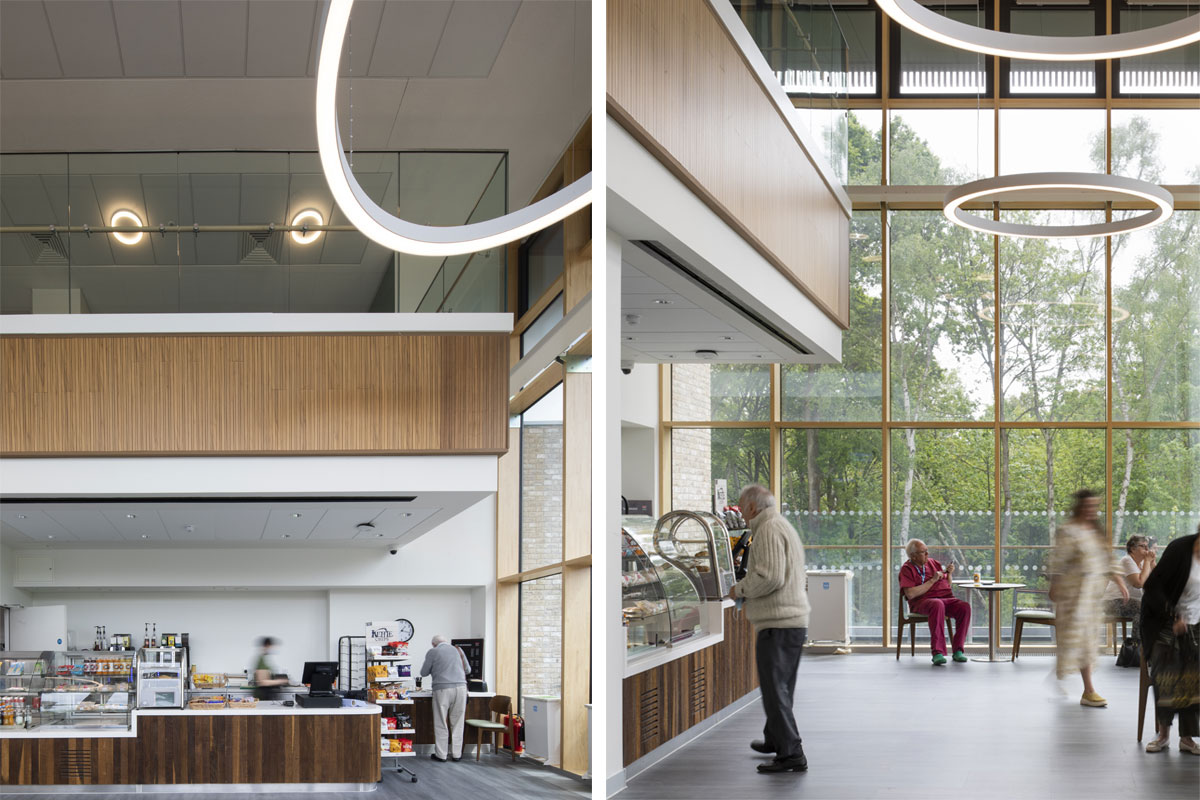
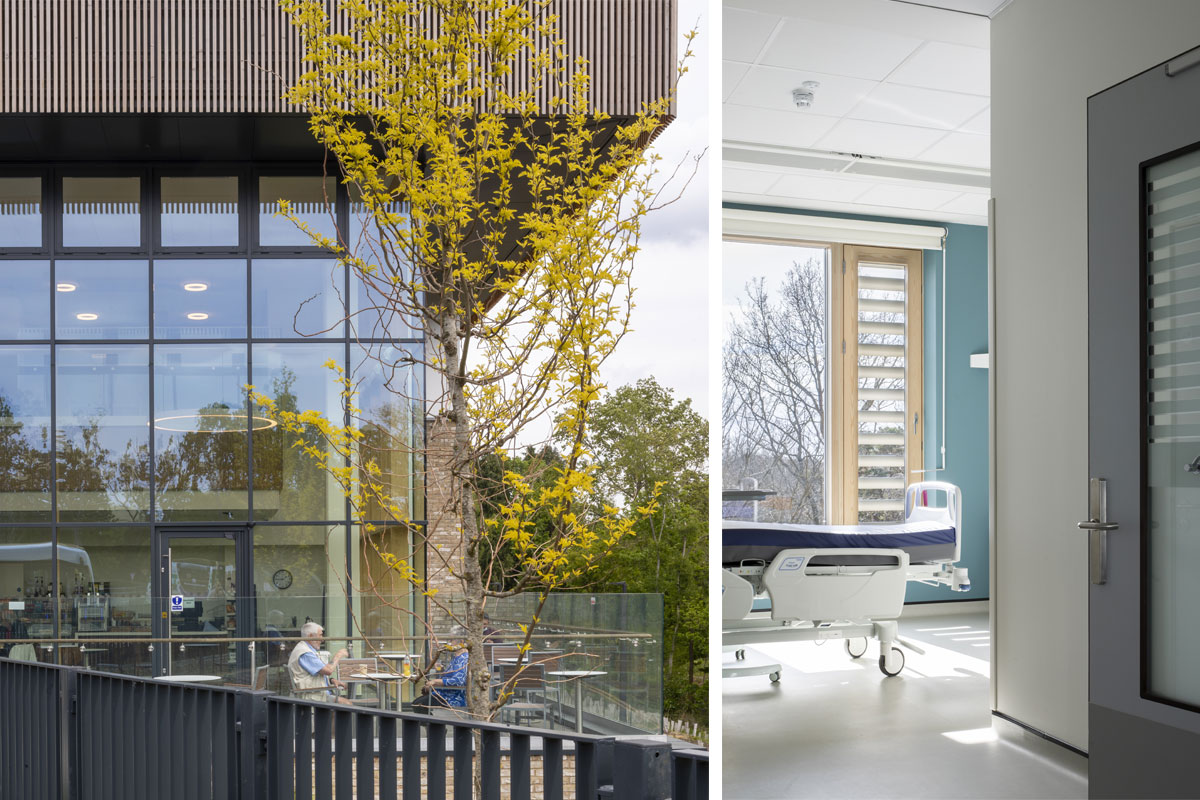
Research (Roger Ulrich) has shown that having a hospital room with a window view of a natural setting has restorative influences, therefore helping to reduce length of stay. At Heatherwood, all rooms have views over woodland, access to terraces and therefore fresh air.
Inpatient accommodation is located on the top floor of the hospital, in what we refer to as a notional treehouse, with close views into the tree canopy. Corridors are relatively short and, in many cases, single sided, with additional full height glazing at their ends allowing access to views and daylight.
Another key plank of our approach was to ensure that the layout and arrangement of the hospital was purposefully compact, minimising travel distances, both internally and externally. The outpatients’ department, indeed the whole of the ambulatory entrance floor, operates as a digitally-enabled one-stop shop of clinical services for patients, which is to say that the patient can have a consultation, imaging and procedure all in one visit, delivering patient-focussed care with high levels of efficiency and safety – reducing stress and saving on car journeys. In most traditional hospitals, the patient would have an outpatient appointment, but if an X-ray or imaging was needed, they would need to go to another building or return another day. At Heatherwood, the idea is that patients have a consultation, then return to the central waiting zone, before being called for their diagnostic test or procedure.
Meanwhile, another floor is entirely dedicated to surgery, optimising the flow, with expansion space designed in to accommodate two more theatres, if needed, meaning that clinical efficiency won’t be compromised. In fact, the Trust is already looking at taking advantage of this opportunity by expanding the unit next year to take the pressure off. Theatres are paired so staff can easily go from one to the other, resulting in optimum efficiency. Indeed, the hospital has introduced several innovative ways of working to increase the number of operations it performs such as trialling orthopaedic ‘super weeks’ where surgeons managed to double the number of weekly joint replacement procedures from 40 to 80. During the ‘super weeks’, some individual surgeons were able to perform ten joint replacement procedures a day by working between two theatres and operating on five patients one after the other in each.
The day surgery unit itself operates on a “medi-room” model of care and its design and layout is informed by Post Occupancy Evaluation analysis from the day surgery unit at Frimley Park Hospital. Following consent, the patient is allocated a medi-room for the duration of their stay. From this multi-functional room, they will change, meet with the anaesthetist and surgeon and wait in gown for their procedure. Following the operation and a short time spent in the first stage recovery unit, the patient will return to their medi-room for second stage recovery, before changing and being discharged. There are a number of benefits to this approach including: improved dignity, with no shared waiting in gowns; larger space to make changing easier, and the patient can be accompanied if desired; a patient-centred rather than consultant-centred approach; and better efficiency in terms of flow.
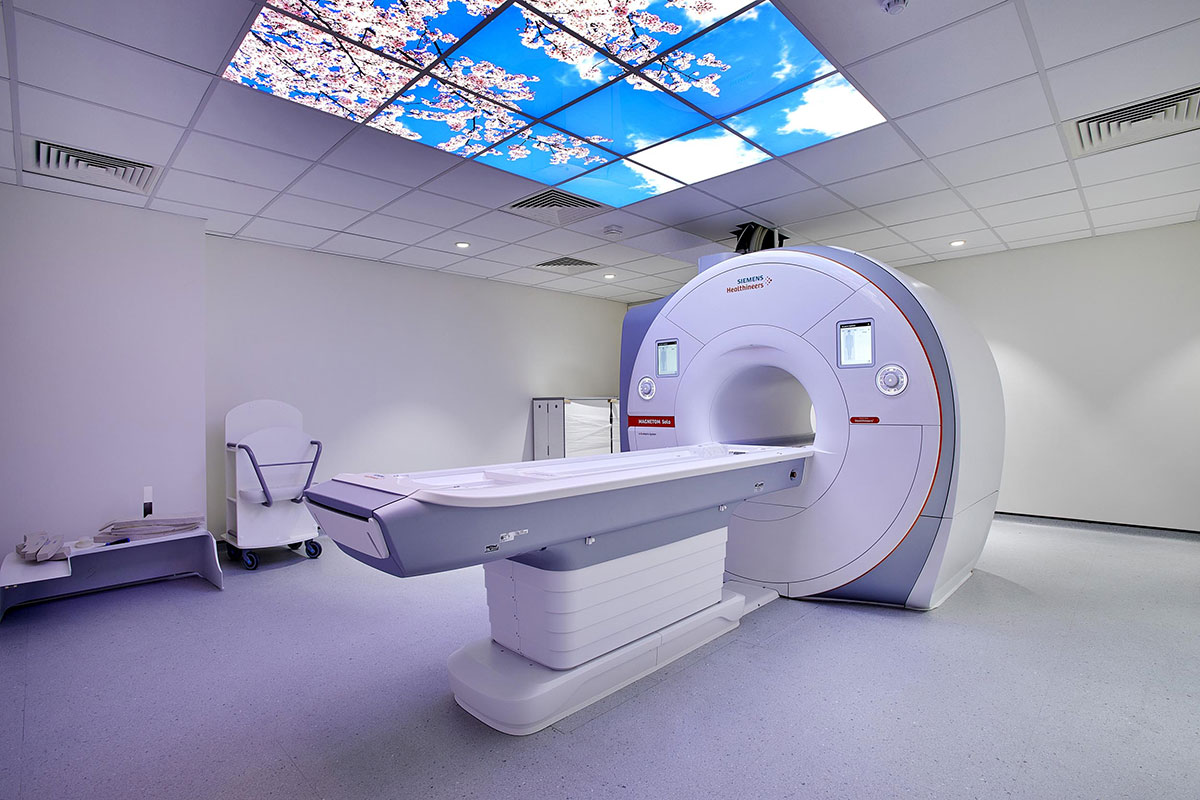
This optimised approach to layout has also supported the Trust’s wider goals regarding the rationalisation of their services across all their sites, by centralising elective services in Ascot leaving space for enhanced acute and emergency care in other locations. Unlike other hospitals with A&E departments, Heatherwood is not affected by the demands of emergency care. It can focus six days a week, morning to night operating, and it doesn’t have to manage emergency patients coming to this facility, stopping clinicians doing this elective work. The new facility is part of the Trust’s strategy to double the number of patients visiting Heatherwood each year to 168,000 over the next decade.
Rakesh Kucheira, orthopaedic surgeon, Frimley Health NHS Foundation Trust, said: “We’re working extremely hard to reduce the waiting lists and get patients the right treatment they need at the right time. As a dedicated planned care centre, we don’t have the same constraints as an acute hospital, we can continuously change the way we work to meet our patients’ needs and really push the system. The results have come from great teamwork with everyone involved in the patient journey working together to improve care for our patients. The feedback we’ve had has been really positive and by safely discharging patients they get to recover in their own homes with our support, surrounded by their loved ones.”
One patient, Amanda Leader, 62 from Wokingham had a hip replacement before Christmas and was discharged the following morning. “I had waited four months after my X-ray for surgery, the pain in my right hip was particularly bad at night-time so I couldn’t sleep. It’s amazing that I was discharged so quickly, I can go to my daughter’s house to recover and I get to see my grandchildren at the same time. I also love dancing and can’t wait to get back to it once I’m properly recovered!” It is heartening to hear this and to look through some of the Google reviews of the hospital online to find that users have referred to “fantastic facilities and staff”, a building that is “lovely, bright and clean”, with comments including, “…I felt very calm from start to finish” and “…I am actually looking forward to my next visit.”
It is our belief that this model should form part of the future of healthcare and bringing together specialist services makes absolute sense, rather than combining lots of different services into one site. By keeping clinical pathways separate, you create efficiencies. By paying careful attention to design, including access to nature, daylight and fresh air, and an optimised approach to layout with built-in flexibility, patients have better health outcomes and reduced recovery periods, whilst the wellbeing of all those using the building is supported, including staff. Of course, many hospitals have started as a central hospital and grown organically, but where there is the opportunity to step back and take a strategic and holistic view of the wider healthcare system or an individual Trust or facility, then we should embrace it.
